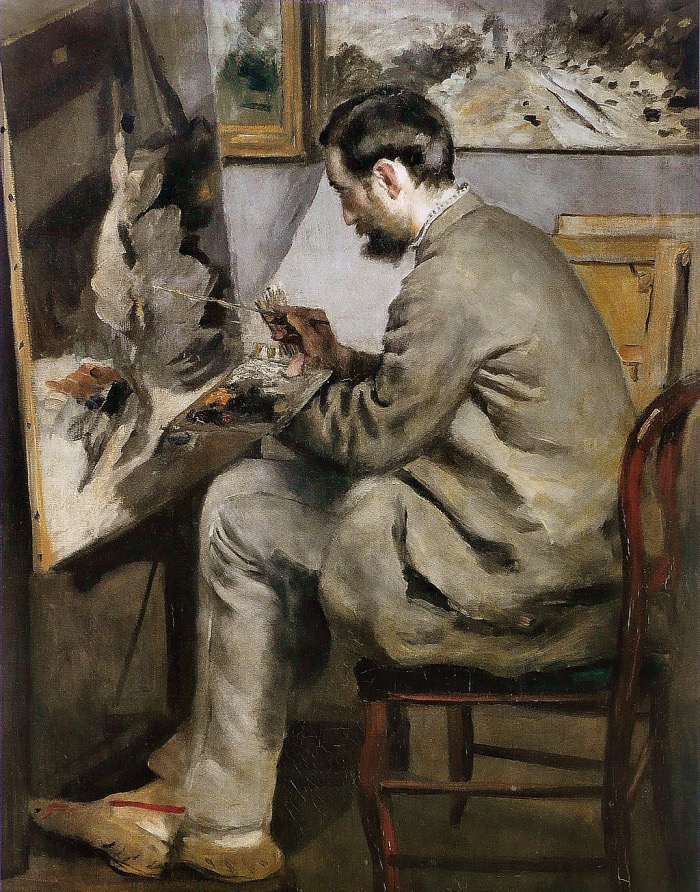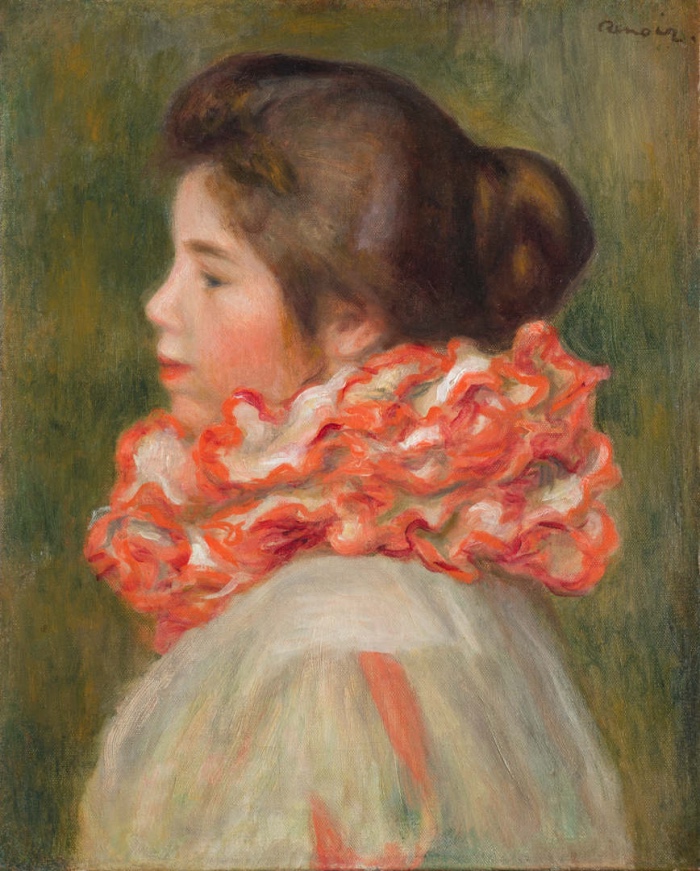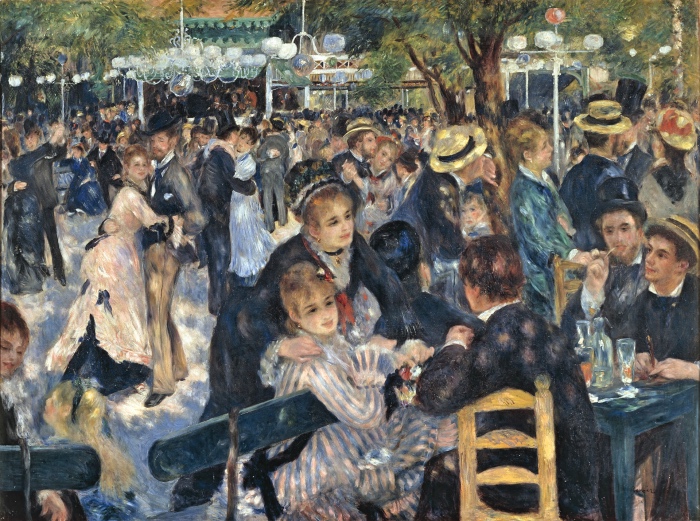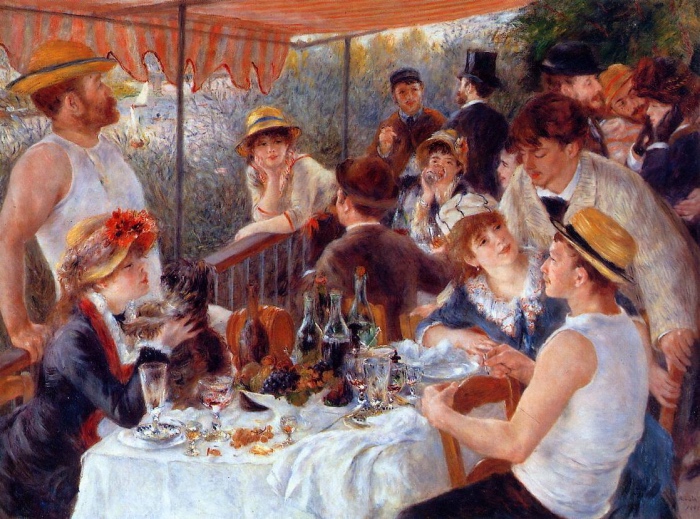
Pierre-Auguste Renoir, Ritratto di Bazille (1867), museo d’Orsay, Parigi
Renoir’s life and works are full of love, light and colour. Indeed, the artist created his masterpieces by drawing on the experiences of his life and described what he saw and experienced with rapid brushstrokes, creating images that seem barely sketched.
Famous for his Impressionist style and for his paintings depicting everyday life, nature and the women in his life, his paintings depict scenes of Parisian life at the time.
Renoir’s art influenced many other artists, including Henri Matisse and Pablo Picasso, and in this post I will tell you about his works in five points.
Life and works of Renoir

Pierre-Auguste Renoir, Girl in a Red Ruff (c. 1896) – Philadelphia Museum of Art, Bequest of Charlotte Dorrance Wright, 1978
1. WHERE RENOIR WAS BORN AND WHEN HE EXHIBITED HIS FIRST WORKS
Pierre-Auguste Renoir was born in Limoges, France, in 1841. He was still in his teens when he moved with his family to Paris, where he started working as an apprentice in a porcelain factory and attended the Paris Academy of Fine Arts, where he studied under Charles Gleyre.
In 1862, Renoir met Claude Monet, Alfred Sisley and Frédéric Bazille and together they formed the group of Impressionist painters.
Renoir participated in the first exhibition of the Impressionists in 1874, where he exhibited some of his works.
His early works were influenced by realism, but he later moved closer to the Impressionist style, which was characterised by the use of bright, vivid colours, the depiction of atmospheric changes and the technique of quick brushstrokes.
One of his first Impressionist masterpieces is ‘Le Moulin de la Galette’, painted in 1876. This painting depicts Parisian social life and culture of the time, with people enjoying a festive afternoon in a windmill on the outskirts of Montmartre.
In the following years, Renoir continued to develop his Impressionist style, painting mainly scenes of everyday life, portraits and landscapes. His work had a great influence on 19th century French painting, and Renoir is considered one of the greatest Impressionist painters of all time.
2. RENOIR’S STYLE
Pierre-Auguste Renoir’s style was influenced by realism and the Impressionist style, but he developed a unique and distinctive artistic identity.
At the beginning of his career as an artist, Renoir mainly painted realist works depicting everyday life, with an emphasis on detail and the accurate representation of people and objects.
Later, under the influence of the Impressionist style, Renoir developed an ability to represent visual and tactile sensations. His technique evolved towards a faster and more lively brushstroke, the use of bright and vivid colours, and the representation of light and its influence on the perception of colour.
In addition, Renoir focused on the representation of beauty, grace and elegance, both in his portraits and paintings of female figures, often with an atmosphere of light-heartedness and happiness.
In summary, Renoir’s style can be defined as a combination of realism, impressionism and the search for beauty, elegance and happiness through artistic representation.

Renoir, Le Moulin de la Galette
3. THE MAIN WORKS OF RENOIR
Pierre-Auguste Renoir was a prolific artist who created many works of great artistic value. Some of his most famous works include:
- Le Déjeuner des Canotiers (The Rowers’ Lunch) – Painted in 1881, it depicts a group of people enjoying an al fresco lunch in a restaurant on the Seine.
- The Clown, painted in his youth for the café of the Cirque d’Hiver (then known as the Five Napoléons), to promote the shows of a famous clown of the time.
- Bal du moulin de la Galette (The Dance at the Mill of the Galette) – Painted in 1876, it depicts Parisian social life and culture of the time, with people dancing and enjoying themselves in a windmill on the outskirts of Montmartre.
- La Grenouillère – Painted in 1869, it depicts a scene of bathers at a beach on the Seine River near Paris.
- Jeunes filles au piano (Young Girls at the Piano) – Painted in 1892, it depicts two young girls sitting at the piano, surrounded by an elegant setting.
- Les Grandes Baigneuses (The Big Bathers) – Painted in 1884-1887, it depicts a group of women bathing in a river.
- Gabrielle and Jean by Renoir, a painting the artist made in about 1895, a particularly happy period in his life, depicting his wife’s cousin playing with his second son.
These works represent only a small fraction of Renoir’s creations, but have been regarded as some of his most significant and representative works.
4. RENOIR’S PRIVATE LIFE, FAMILY AND CHILDREN
Pierre-Auguste Renoir was known as a sociable and affable man with a passion for life and art. He was married to Aline Charigot, a model and dressmaker who had posed for some of his works, and together they had three children: Pierre, Jean and Claude.
Renoir was very close to his family and often painted portraits of his wife and children. His wife Aline was also his assistant and helped him run his studio.
However, Renoir’s family life was not always easy. In 1890, Aline contracted tuberculosis, a disease that would affect the rest of his life.
Despite the difficulties, Renoir continued to work and produced paintings and drawings until the end of his life. He died on 3 December 1919, at the age of 78, of pneumonia.
His artistic legacy was of great importance for the history of art, and he is still considered one of the greatest French painters of all time.

Pierre-Auguste Renoir, La colazione dei canottieri (1881).
5. CURIOSITIES ABOUT RENOIR
Renoir was of humble origins, his father was a tailor and his mother a milliner. The Renoir family lived in Limoges, a town in the centre of France. Despite his humble origins, it was his artistic talent that opened the doors to him at the École des Beaux-Arts, but he soon abandoned his studies to join a group of bohemian artists, including Édouard Manet,Claude Monet and Edgar Degas.
Renoir’s life was characterised by suffering from a severe form of rheumatoid arthritis, a disease that worsened with age. Nevertheless, he continued to paint until the end of his life, although he often needed the help of assistants and friends.
Renoir was known for his love of women and female beauty. One of his most famous paintings, The Rowers’ Lunch, was made during a stay in Chatou, near Paris, where Renoir met and fell in love with Aline Charigot, the girl who would later become his wife and the mother of his children.
Renoir had a famous son, Jean Renoir, who became one of the most important directors in French cinema. Born in 1894, Jean was the second son of Renoir and Aline Charigot.
Jean Renoir, growing up in a family of artists, took an early interest in acting and directing and in 1924 directed his first film, ‘Catherine’, and from then on worked as a director for film and television for many decades.
Among his most famous films are ‘The Great Illusion’ in 1937 and ‘The Rule of the Game’ in 1939, considered masterpieces of French cinema.
Jean Renoir was known for his ability to create realistic and complex characters, and for his ability to combine humour, drama and social criticism in his films.
Jean Renoir died in 1979 at the age of 84, but his work as a filmmaker continues to be admired and studied around the world.

